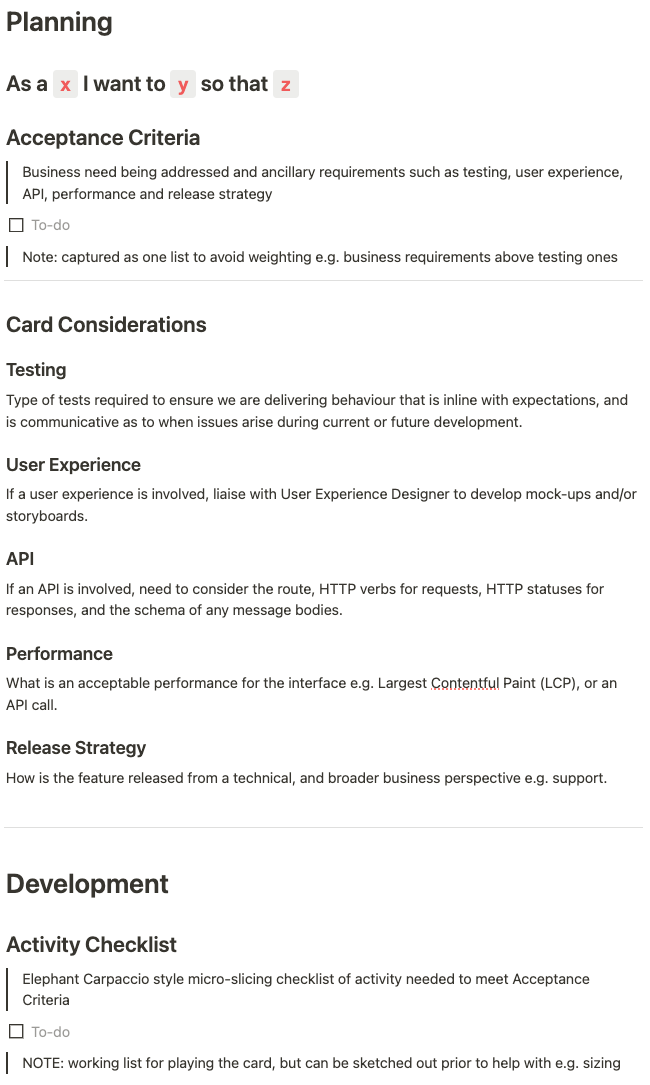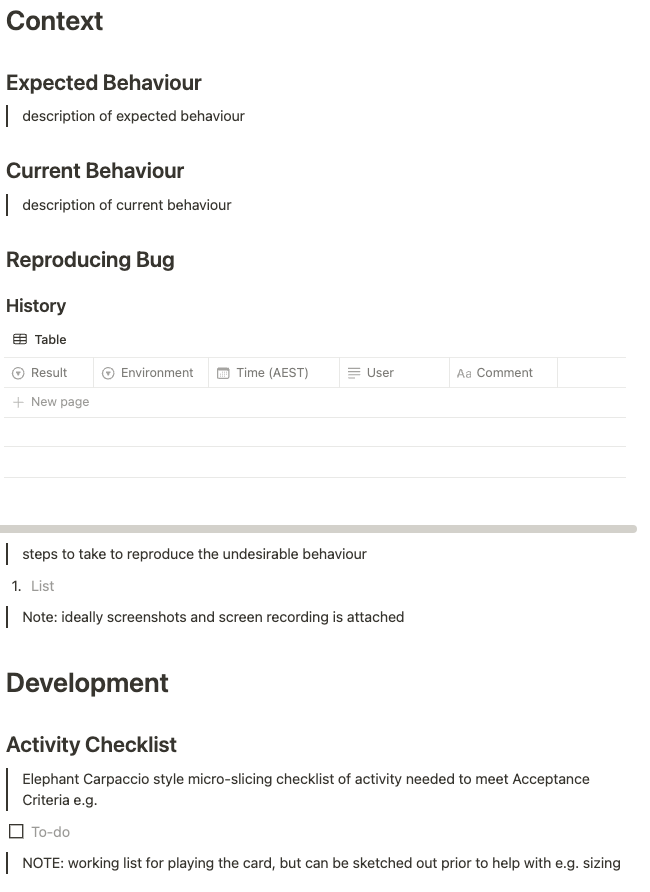Published on
Epic, Story, and Bug Templates for Task Management Software
A well-structured Epic, Story, and Bug template improves clarity, ensures alignment across teams, and reduces friction in execution. Below is a practical guide for structuring these in your task management system.
Task Properties
Status
Represents the different stages of the workflow, and are represented on a Kanban board as the columns.
- Backlog:
- Can be added with just the title to capture discussion points for prioritization.
- Limit to e.g. 1 Epic, 2 Stories, and 5 Bugs per Reporter to force prioritization and promote providing details to be able to move to "Ready for Development" (Stop starting, start finishing).
- Track how long an item has been in the Backlog to facilitate pruning of stale items and encourage refinement.
- Ready for Development:
- All properties and template sections must be populated.
- Track how long an item remains in this state to highlight potential prioritization issues.
- In Development:
- Limit to 1 Epic, and 1 Story or Bug per person.
- Track time spent in development to monitor progress and detect potential blockers, gold-plating, or inefficiencies in the system of work.
- For Stories, time in development contributes to tracking Lead Time for Changes.
- For Bugs, time in development contributes to tracking Mean Time to Restore.
- Blocked:
- Task is blocked due to a dependency (e.g., cross-functional, vendor).
- Track time spent in this state to identify persistent bottlenecks, ownership issues, or delegation challenges.
- Done:
- Task is complete and meets "Definition of Done."
- Track cumulative time spent in the workflow as an indicator of overall efficiency and a lead indicator for progress towards OKR.
- Archived:
- Completed tasks no longer actively discussed but retained for visibility.
- Track sequence of completed work to understand delivery trends over time.
Reporter
The Reporter is the individual who identifies and documents the need for a task, whether it be an Epic, Story, or Bug. While the Reporter is responsible for providing enough context for prioritization, they are not necessarily the person who will complete the work.
- Reporters should provide enough context for the task to be understood and prioritized but should avoid over-specifying the solution.
- The responsibility of refining and scoping the task should be a team activity.
- The Reporter does not own the task but should be available to clarify details as needed.
- Limiting the number of tasks a single Reporter can submit (e.g., 1 Epic, 2 Stories, 5 Bugs) prevents backlog bloat and encourages focus on high-priority work.
Assignee
Assigned at the last responsible moment to prevent the concentration of certain types of work to specific individuals, which can create knowledge silos and reduce team-wide expertise. Delaying the assignment allows for a more even distribution of work and helps cultivate cross-functional skills across the team.
- Epic: Accountable person for the successful delivery of aggregated work.
- A great opportunity for a team member to take ownership of a larger body of work, enhancing their work management and leadership skills.
- Story: Individual contributor (or pair) actively working on the implementation.
- Encouraging different team members to take ownership of similar work over time helps prevent skill bottlenecks and promotes collective ownership.
- Bug: Individual contributor (or pair) responsible for identifying and implementing the fix.
- Assigning bugs dynamically rather than to a single dedicated person ensures distributed knowledge of system behavior and avoids dependency on a single individual for debugging efforts.
Business Value
A Discrete Visual Analog Scale representing business value:
- Tactical: Often short-term efforts representing a side quest that can be deprioritized unless the effort is low. Tactical items may provide incremental value but should be assessed carefully to avoid distracting from strategic goals.
- Strategic: Often medium-term efforts focused on committed OKR. These are objectives that must be achieved within the defined period, aligning with key business priorities.
- Transformational: Often long-term efforts focused on aspirational OKR. Transformational efforts should be evaluated carefully to avoid a YAGNI (You Ain't Gonna Need It) moments, where premature optimization leads to wasted effort. If a transformational task is not clearly tied to long-term value, it may not be worth prioritizing.
Delivery Effort
A Discrete Visual Analog Scale representing task effort:
- Complex: The largest effort allowed by the team for a single task (Large if using t-shirt sizing). Anything bigger should be split into multiple smaller tasks. This size is generally not ideal as it increases the risk of blockers, gold-plating, or performance/system-of-work issues, which take longer to surface. Tasks of this size should aim to be deliverable within 2 to 4 workdays.
- Reasonable: The ideal task size (Medium if using t-shirt sizing). Ideally, these tasks should be actionable in approximately a workday to minimize the "what was I doing on this?" problem when resuming work the next day or week. This size balances granularity and efficiency without adding excessive overhead.
- Simple: The smallest task size allowed by the team (Small if using t-shirt sizing). While they may seem efficient, small tasks introduce frequent context switching for the contributor and increase management overhead. Overuse of simple tasks can fragment work unnecessarily and reduce productivity.
Parent
Indicates hierarchical relationships:
- Epic: Parent of a Story.
- Story: Parent of a Bug.
- These links are used to track and report on "Change failure rate."
Epics
An Epic encompasses multiple tasks needed to achieve a broader business goal. Epics should be kept lightweight, focusing on a single Objective and set of Key Results that align with the team OKR (Objectives and Key Results). This approach ensures clarity for both technical and non-technical stakeholders while maintaining flexibility.
Structure
- Objective: A specific and clearly defined goal that is easy to understand by anyone in the business.
- Key Results: A set of S.M.A.R.T. (Specific, Measurable, Achievable, Realistic, and Timely) criteria to track the progress of the objective.
Considerations
- Ensure the objective is well-articulated and concise.
- Key results should be measurable and objectively verifiable.
Example

Stories
A Story represents a single, user-centric piece of work that delivers a meaningful outcome. Stories provide detailed, actionable steps for team members. They should be structured to clearly communicate the persona, the need, the reason behind the need, and the value delivered to the persona. If a story does not provide tangible value, it may indicate an attempt to game delivery metrics or suggest that the work should be framed as an Epic instead.
Structure
- User Story: "As a [persona], I want to [action], so that [reason]."
- Acceptance Criteria: A single (to avoid prioritizing any one of the criteria over the others), concise list covering:
- Business need being addressed.
- Testing requirements (e.g., unit, integration, regression tests).
- User Experience considerations (liaise with UX designers for mock-ups/storyboards).
- API details (route, HTTP methods, response statuses, schema, etc.).
- Performance expectations (e.g., Largest Contentful Paint, API response time limits).
- Release Strategy (technical and business perspectives, including support considerations).
In-Progress/Working Section
- Activity Checklist:
- A micro-sliced list of actions required to complete the story, created as work begins.
- Based on the Elephant Carpaccio technique (see more here).
- Helps ensure continuity if another engineer needs to take over the story.
Example

Bugs
A Bug represents a defect or unintended behavior in a system that deviates from expected functionality, performance, or user experience. Bug reports should provide clear and reproducible information to aid efficient resolution.
Structure
- Context:
- Expected Behavior: A concise description of the correct behavior.
- Current Behavior: A description of the undesirable current behavior.
- Reproducing the Bug:
- Step-by-step reproduction guide.
- Table for tracking failure/success cases:
- Result (FAIL/PASS)
- Environment (DEV/TEST/PROD)
- Time
- User
- Comment
- Encouragement to attach screenshots and/or screen recordings.
In-Progress/Working Section
- Activity Checklist:
- Same format as stories, providing a clear outline of steps needed to address the bug.
Example

Why This Format Works
- Low Friction: The templates are lightweight and encourage meaningful participation.
- Concise & Structured: Bullet points and checklists promote clarity and brevity.
- Improved Collaboration: The Activity Checklist ensures seamless hand-offs between team members.
- Actionable & Measurable: Clear criteria and structured documentation reduce ambiguity.
By keeping templates lean and emphasizing clarity, teams can work with greater autonomy and effectiveness while ensuring efficiency and alignment across all work items.
